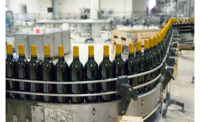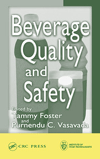Product Safety Demand Grows
By SARAH THEODORE
New technologies help ensure beverage safety and efficacy
An outbreak of E.coli in fresh spinach, a fast food-related E.coli outbreak, and a botulism toxin linked to a carrot juice product, all occurring within a few months of each other last fall, have put product safety front and center in consumers’ and regulators’ minds in 2007. Late last month, the U.S. Government Accountability Office placed food safety on its list of high-risk areas “warranting attention by Congress and the executive branch.” And some members of the new Congress, including Connecticut Rep. Rosa DeLauro and Illinois Sen. Dick Durbin, came back to Washington in January touting product safety reform as part of the new agenda.
On the business side, demand for food safety products
in the United States is expected to exceed $2 billion within the next three
years, according to the Freedonia Group, a Cleveland, Ohio-based industrial
research firm. Interest will be led by the development of new products,
renewed federal interest in eliminating foodborne illness, concern over the
arrival of avian influenza in North America, and the development of a
National Animal Identification System. The company’s Food Safety Products report
indicates that disinfection and sanitation chemicals will lead the food
safety market. But the primary driver of disinfectant product sales will be
“new types of disinfection equipment as companies —
particularly in the beverage industry — seek reliable, non-chemical
means of ensuring that contamination risks are minimized.”
The report’s comments are echoed by food safety
experts who say beverage companies, particularly those focused on health
and wellness, are seeking new technologies that ensure the safety of their
products while also maintaining efficacy. Traditional high-temperature
pasteurization can damage product flavor and functional ingredients in
addition to the harmful organisms it is intended to destroy. But newer
technology has the potential to kill or inactivate pathogens while
preserving the favorable components of a product.
“Beverages are an absolutely wonderful platform
for health — for functional, bioactive components,” says Martin
Cole, director of the National Center for Food Safety and Technology
(NCFST), Chicago. “Companies are struggling with how to ensure safety
but preserve functional bioactivity because many of these bioactives that
we’re trying to promote — antioxidants, polyphenols, things
like that — many of them are sensitive to heat,” he says.
“That’s why there is a lot of interest in non-thermal
technologies.”
Much of the work in alternative pasteurization methods
for beverages was driven by the fresh juice industry and the Food and Drug
Administration regulations that went into effect in the mid-‘90s
requiring a five-log reduction in pathogens for unpasteurized juice
products. Some of those cold pasteurization techniques include the use of
ultraviolet light, high-pressure processing and pulsed electric fields.
“One of the wonderful innovations that we saw
with the fresh juice industry was the use of ultraviolet light being used
to pasteurize apple cider,” says Don Schaffner, extension specialist
in food science at Rutgers University, and a food safety expert with the
Institute of Food Tech-nologists.
“There is some clever technology there,”
he says. “The key thing with UV light is the penetration depth. What
some innovative folks did was say, ‘We need a way to control the flow
rate of the apple cider so that cloudy cider will flow more slowly to give
better UV penetration, and juices that are less cloudy flow more quickly.
We’ll control the flow rate based on the turbidity and that will
allow us to deliver the appropriate ultraviolet dose.’”
Not as common in the United States, but showing
promise elsewhere are pulsed electric field technology, which the
NCFST’s Cole describes as “punching holes in the microbial
membrane,” and high-pressure processing, which uses extreme
hydrostatic pressure to destroy harmful organisms.
“The bottom of the ocean is about 100 mega
pascals, and you’re talking about six times that for these
pressures,” Cole says. ”You get the pasteurization of the bad
guys but you leave all vitamins and flavors intact.”
The NCFST is a research consortium comprising the FDA
Center for Food Safety and Applied Nutrition, the Illinois Institute of
Technology and the food industry. Its responsibilities include validating
food safety techniques, and Cole says some of
the testing on high-pressure processing has resulted in juice products that
almost cannot be distinguished from fresh juice.
High-pressure pasteurization currently is being used
by Fresherized Foods, formerly known as AvoMex. The company uses the
technology on food products such as guacamole and has introduced Fruitmost
smoothies and juices. Genesis Juice Corp., Eugene, Ore., has used pulsed
electric field technology for its juices.
Cole says the definition of pasteurization has been
redefined by the USDA’s National Advisory Committee on
Microbiological Criteria for Foods, allowing cold pasteurized products to
be labeled as pasteurized.
“They’re redefining pasteurization as the
required outcome or step in pathogen reduction,” he says. “So
it opens it up to these other technologies.” However, debate
continues as to whether the products can be labeled as fresh.
The fresh juice industry might originally have been
the focal point for these new technologies because of the FDA’s
requirements, but it also is good testing ground for other reasons, says
Larry Hobbs, executive director of the International Society of Beverage
Technologists (ISBT), St. Paul, Minn. The sensitive sensory nature of juice
means a sterilization process that passes the juice test likely can be
applied to other beverages.
“Juice is probably a good test point from the
standpoint that it is somewhat sensitive to flavor issues,” he says.
“So if it works in juice, in all likelihood, it’s going to work
in other areas as well.”
Controlling the process
Another result of the FDA’s fresh juice
regulations was the implementation of Hazard Analysis Critical Control
Points (HACCP) programs. Food safety experts say all companies, regardless
of whether they are required to file a HACCP plan, will benefit from having
one.
“I would say that even if you are not under
mandatory HACCP, a great way to start making a safe food is to start with
the seven principles of HACCP,” Schaffner says. “Going though
that exercise gets you a long way toward producing a safe and high-quality
product.”
Bob Hirst, vice president of education, science and
technical relations at the International Bottled Water Association,
Alexandria, Va., adds: “A good HACCP plan is comprehensive enough to
address all possible hazards, but efficient enough to allow good control of
the process while minimizing overall impact on production
volumes.”
The most important prerequisite to establishing a
HACCP plan, Hirst says, is to involve all parts of the plant’s
operations, provide training and meet at regular intervals to review the
program and assess its effectiveness. Both the FDA and USDA provide
information resources for setting up a program.
In addition to keeping consumers healthy, food safety
in the post-9/11 world also is a matter of national security. “Today
you have the potential for a much more serious threat of someone who might
want to intentionally put something into the food supply that could injure
consumers or do a lot of damage to a trademark for political issues,”
says ISBT’s Hobbs. “In this case, trying to define your system
in terms of those issues calls for a completely different type of
focus.”
With assistance from the FDA or USDA, he says,
companies can develop a program to assess and manage their exposure to such
intentional threats. Similar to HACCP, a threat management program helps
companies evaluate their individual risks and tailor security to their own
operations.
A number of food and beverage associations, including
the American Beverage Association, also were involved in creating the
standards for the Public Health Security Bioterrorism Preparedness and
Response Act of 2002.
“Everyone was very open about ideas they had to
improve food security,” says Mike Redman, vice president of
scientific, technical and regulatory affairs at the American Beverage
Association, Washington, D.C. “Over the past few years, the industry
has come a really long way.”
Among the requirements applicable to beverage
operations were the registration of food facilities, prior notice of
imported food shipments, and records establishment and maintenance
provisions.
“Prior to that time, there was not a single
federal system for registering food facilities,” Redman says.
“A number of other countries already had that in place, but believe
it or not, we did not have that in place in the United States.”
Today, any facility that produces, warehouses or distributes food for
consumption in the United States, whether located in the United States or
abroad, must be registered with the FDA.
In addition, the FDA must be notified of any imported
food product or ingredient coming into the United States, and imported
products must be received through an authorized port of entry. And the 2002
law established standards for record-keeping that Redman describes as a
“one up and one down type of reporting.”
“Everyone who receives a food or ingredient has
to be able to trace that back one step,” he explains. “By doing
that, you can trace something all the way to the original source. You also
have to then be able to trace it forward as well. If you have a shipment
that goes out of your facility, you have to be able to identify where that
went.”
Redman says most beverage facilities already had such
programs in place, but, “This is a very specific system as far as the
information required and how quickly you have to be able to provide that
information — all of that has been formalized through these
regulations.”
Despite the need for increased security measures and
the recent publicity surrounding foodborne illness, ISBT’s Hobbs says
the U.S. food supply is among the safest in the world. “Every
industry, without exception, takes food safety and concerns about the
consumer very seriously,” he says. “They have to — their
brand is at stake. People are taking a look at best practices in other
industries and how they can apply them to their industry. I really think
that the American food chain is probably as safe as you will find anywhere
in the world and people are working very hard to make it even more so.”
What does the public think?
As far as consumers are
concerned, the government bears the brunt of the responsibility
for food safety, according to the Food Safety Policy Center at Michigan
State University. Andrew Knight, visiting assistant professor, presented
“Attitudes Toward Food Safety and the National Food System: Results
from a National Survey” to a USDA audience last year.
Almost 40 percent of respondents to MSU’s survey
indicated that the federal government is the group that should be most
responsible for ensuring product safety. Twenty-three percent said
processors should be the main line of defense, and 11 percent or less
indicated that groups such as retailers, restaurants and consumers
themselves were responsible for maintaining product safety.
By age, those 45 to 54 years old were most concerned
with product safety, followed closely by the 35- to 44-year-old age group.
African Americans ranked far higher than any other ethnic group in their
worries over product safety, with 70 percent indicating they have concerns,
compared with less than 40 percent for other ethnic groups.
Pesticides and chemical residue were the most common
worry, with 70 percent of respondents expressing concern. They were
followed closely by foodborne illness/pathogens at 68 percent, additives
and preservatives at 52 percent, and antibiotics and hormones at 50
percent.


